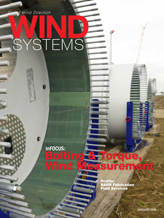On December 12, New Energy Update presented a webinar on gearbox upkeep, focusing on how a gearbox’s maintenance requirements should be approached in order to keep them operating at peak performance. Carsten Andersen, founder and CEO of Danish Wind Power Academy, presented a video and answered questions presented by Wind Systems magazine as well as questions posed by the webinar attendees.
More than 750 people signed up for the webinar, which was full of interesting insights from Andersen on how best to keep gearboxes working smoothly.
Here are some highlights from the webinar:
- Overall, normal asset management isn’t efficient enough to help with the lifetime of a gearbox.
- It is necessary to know the load of individual turbines if you want to be able to evaluate your gearbox lifetime. From an inspection perspective, how can you determine lifetime if you don’t know how loaded your machine is?
- There’s no way we can evaluate remaining time in a gearbox if we don’t know the operation conditions.
- Nominal oil temperature would be somewhere between 63 and 65 degrees. But if you get above 10 degrees of nominal operation, then you will cut the lifetime of your gearbox oil in half.
- It’s important that we keep the gear oil temperature down, which means we need to focus on the coolant system around it. And it’s also about cleanliness of the oil.
- Oil sampling is one of the most important and cheapest indicators that can be done to keep a check on oil condition in the gearbox.
- On onshore, at least two oil samples should be taken a year to help focus on maintenance.
- Less than 10 percent of the oil samples sent to laboratories are representative. They’re either too old; they’re taken under the wrong conditions; they’re taken in dirty bottles; they’re taken with dirty hoses.
- Oil samples are very straight up and down if it’s taken the right way and analyzed the right way.
- A refined method to take oil samples under the same conditions is needed. Samples have to be taken when they’re warm and representative of the operating conditions.
- You need to have a reference inspection of the oil when the gearbox is new, a few weeks after it’s put into operation.
- An inspection should be done at year one and then another at year 2. If you find things haven’t changed then maybe inspections can be extended to once every two years.
- Document good things. Many people are only documenting bad things. If you don’t document how things look when they’re perfect, then you don’t have a benchmark to refer back to.
- You need to take the sample in a clean bottle, and even if you think it is clean, you should flush it. The hoses should also be cleaned and flushed.
- High load is actually nice if it’s clean and the roughness of the terrain doesn’t give you too much turbulence, but that’s rarely the case.
- Predictive maintenance is a valuable tool, but it’s not black or white — that and nothing else.
- Predictive maintenance technology must be supported with human brains and ownership in operations.
- Gearboxes are getting bigger, but the tolerances are getting smaller. They are much narrower and more precise than they used to be.
- We cannot afford to buy the gearbox that lasts 20 years, but of the ones available, we can maintain them nicely and operate them nicely in order to get the necessary life out of them.
- The gearbox is reliable, but the way we are treating it is not.
- About 60 to 80 percent of downtime is related to people not doing things they should do when they do maintenance.
For more information, go to newenergyupdate.com/








































